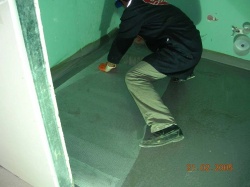Get Support
123-456-789-10
Waterproofing Damp Environments such as Bathrooms, Kitchens and Toilets in the Construction Phase
Damp environments are mostly coated with ceramics. Although ceramics are waterproof, this type of coatings are not sufficient for a complete waterproofing. Ceramic joints are risky areas in water transmission. The formation of cracks at wall-to-wall and wall-to-floor intersections mostly simplify water leakage. And it is the same with other critical points such as installation pipes or water outlets. Water leakage from damp environments lead to damage in the storeys below or in the adjacent rooms. So the best solution is to waterproof damp environments in the construction phase. This can be perfectly achieved by using Permo Chim Duo, plaster netting (Figure 4) as well as the kind of outlets which are compatible with waterproofing application.
After having applied levelling alum the edges must be filleted. Concrete surfaces must be saturated with plenty of water and Permo Chim Duo grout prepared with a low speed mixer must be applied onto the ground as well as the required part of the walls. Alkali resistant plaster netting must be pressed into the grout before it dries up. When the first coat is dry-wet a second coat of Permo Chim Duo is applied to complete the insulation.
Ceramics must be applied within 1-2 days maximum. To waterproof ceramic joints, Emulzer Latex must be added to the mixing water in the preparation of joint paste.







